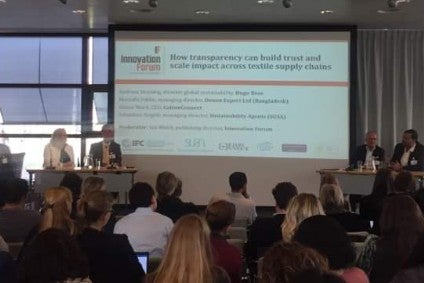
Mostafiz Uddin, managing director of Bangladesh-based jeans manufacturer Denim Expert Limited, has called for “true transparency” from apparel brands by converging and sharing their factory audit results – and being open about the true cost of their garments.
Speaking at the Innovation Forum’s Sustainable Apparel and Textiles Conference, which took place in the Netherlands this week, Uddin claimed that, at present, factory owners in sourcing countries such as Bangladesh face an “onerous” number of audits from different apparel brands and retailers, most of them gathering the same information.
“Why can we not converge audits by sharing audit information across all brands within one central database?” asked Uddin, whose business exports around 3m pairs of jeans annually for customers including many of the world’s leading apparel brands and retailers. “Multiple factory checks and audit fatigue is a serious issue for suppliers.”
Such a move towards factory audit compliance would boost transparency, cut costs and reduce audit fatigue he claims. He also wants greater transparency from brands on the true cost of clothing, including improving information on staple clothing items such as jeans and T-shirts.” At the moment, he says, the public “remain in the dark” on such issues.
“Suppliers have done their bit [on transparency] – it’s time for brands and retailers to commit to full transparency.”
Uddin’s overriding point, however, is that the Bangladeshi ready-made garment industry has witnessed an “unprecedented overhaul” since the collapse of the Rana Plaza building outside of Dhaka in 2013 – meaning it is now the safest in the world and factory owners in the country now have “nothing to hide.”

US Tariffs are shifting - will you react or anticipate?
Don’t let policy changes catch you off guard. Stay proactive with real-time data and expert analysis.
By GlobalData“Our factories have cooperated with the various safety initiatives and made their safety reports publicly available, which is unique in the global apparel supply chain,” he said. “Third parties are auditing our factories in a transparent procedure to check social compliance, and we are engaging with other standards such as the Higg Index and LEED Building Certification. We also have safety hotlines so that workers can register their concerns in the most transparency way.
“Meanwhile, the C&A Foundation has funded a live online map for each and every factory in our RMG industry so that people across the world now know exactly where our factories are located and their compliance status.”
Uddin, who is also the founder and CEO of the Bangladesh Denim Expo trade fair, said despite this progress, more support is needed from apparel brands in order to achieve “true transparency.”
“Transparency itself cannot be sustainable if buyers don’t make their business processes transparent,” he said. “Fashion is one single, global supply chain connecting consumers, retailers and suppliers. If buyers are not transparent then the chain breaks.”
Uddin reinforced his message by suggesting that unit costs for apparel have in some cases declined since the Rana Plaza tragedy in 2012, despite “it being widely acknowledged that the cheap price of clothing was a key contributor to the accident as suppliers cut corners to meet the requirements of buyers.”
He added: “After Rana Plaza, we were told that this was the price we pay for cheap clothing. Yet since then, as suppliers, we still haven’t seen any increases in unit costs.
“I see so many discussions going on worldwide about transparency in apparel supply chains. However, we really need to review whether these discussions are making a difference or are simply talking shops within the industry.”



